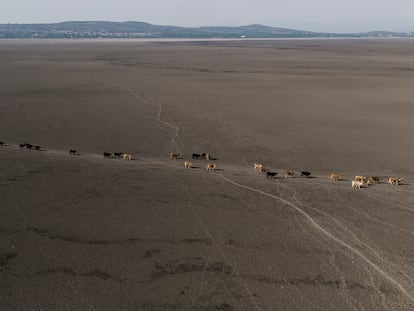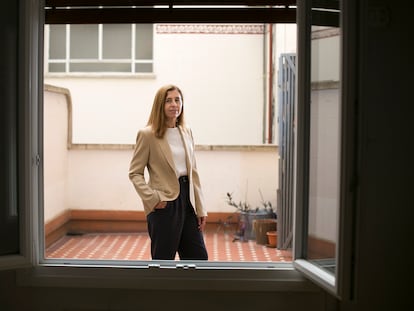Sub-Saharan Africa, the renewable paradise where not everyone has access to electricity
The continent, which is holding its climate summit on Monday, has more countries with a majority of ‘green’ electricity than any other region, but a significant proportion of its inhabitants lacked electricity in 2021
Upon visiting the website of the African Climate Summit, which was held in Nairobi, Kenya, earlier this month, one sees images of dozens of wind turbines spinning in unison. And, indeed, sub-Saharan Africa, where Kenya is located, might seem to be a climate change activist’s dream. It’s the only region in the world that has so many countries where renewable energy sources are so important in the electricity/energy landscape. As of 2021, they accounted for over 99% in the Central African Republic, Ethiopia, and the Democratic Republic of Congo, and over 90% in Kenya, Namibia and Uganda, according to data from the Energy Institute and the Ember think tank.
But on second glance, the problem arises when one differentiates between energy and electricity. According to a report by the PricewaterhouseCoopers consultancy, only 9% of the energy generated in Africa — that is, the supply that illuminates homes and powers industry and transport — came from renewables in 2020. And according to data from the Mo Ibrahim Foundation, electricity accounts for only one-fifth of the world’s total energy consumption. By sector, electricity accounts for 28.5% of the energy used by industry, 25% of “residential” energy and just 1.2% of the energy consumed in transport.
That problem is particularly severe when one factors in the concept of energy poverty, a category that, unfortunately, sub-Saharan Africa leads. According to data from the United Nations Conference on Trade and Development (UNCTAD), in 2021 50% of the region’s citizens still lacked access to electricity, with particularly serious cases like Burundi, Chad and South Sudan, where the percentage of the population without electricity was as high as 90%. As Wikus Kruger, the director of the Power Futures Lab at the University of Cape Town, says, “with the exception of South Africa [where coal-dependent electricity generation is comparable to that of other industrialized countries], in most sub-Saharan countries the electricity generation systems are tiny, with a combined production capacity that does not reach that of countries such as France and Spain.”
But first, the good news: why does the region have such a widespread deployment of renewables? Part of the reason has to do with water resources in countries like the Democratic Republic of Congo, Zambia, Ethiopia, Uganda, Mozambique, Angola, Kenya, and Rwanda. According to Kruger, the impetus for hydropower dates back to colonial times, when European countries “built the dams they needed in Africa to supply their power mines.” Hydropower has continued to expand since then, with major development in Ethiopia (the Renaissance Dam on the Blue Nile) and new projects in Malawi, Burundi, and Mozambique, which is building a 1,500-megawatt dam on the Zambezi River.
The problem with dams is that they are not immune to climate change, says Grace Tamble of the Energy for Growth Hub think tank. “Droughts, floods, changing rainfall patterns... they all have an impact on hydropower generation, as has happened, for example, in Zambian supply outages.” The unpredictability of renewables means that, in many countries, there isn’t a simple substitute for natural gas-fired thermal power plants as stabilization mechanisms, Kruger emphasizes. One exception, perhaps, might be the countries that have the potential to develop geothermal power in the Rift Valley.
“The good thing about geothermal energy is that it is stable and there is a lot of potential,” says Naomi Wagura, the country programs manager at the NGO Global Energy Alliance for People and Planet (GEAPP). “In East Africa alone, there is potential for about 20 gigawatts; that figure represents many times the current installed capacity.”
One of the countries most blessed by wind and geothermal energy, Kenya, has experienced some of the greatest gains in electricity access: according to World Bank data, it went from 15% of the population in 2000 to 77% in 2021. In comparison, over the same period, the average for the entire sub-Saharan region went from 26% to 50%.
As for other types of energy, like solar energy, as of 2022, Africa has 40% of the world’s energy generation potential but only 1% of its installed capacity, according to data from the Mo Ibrahim Foundation.
The problem is poverty
The lack of electricity has much to do with poverty. According to a study by the International Energy Agency (IEA), in sub-Saharan Africa’s poorest households, the price of electricity to power a couple of basic appliances represents one-tenth of household income. That’s why, Wagura explains, there is so much focus on electrification to generate economic growth. “When we talk about energy poverty, we are also talking about outright poverty,” she notes. “Many of the communities lack money, so running an electrical grid that doesn’t improve the community’s economic possibilities may not be viable in the long run.”
One consequence of this poverty is the government’s imposition of maximums on electricity prices. The measure relieves citizens’ pockets, but it also complicates the financial viability of state-owned electricity companies, many of which are bankrupt and unable to attract outside investment.
As of 2021, some 50% of Africans still lacked access to electricity. In Burundi, Chad and South Sudan, the percentage of the population without access to electricity was as high as 90%.
In a report published in 2022, the IEA estimated that the entire African continent would need to double its total generation capacity (from the current 260 gigawatts to 510 gigawatts) to meet UN Sustainable Development Goal 7: ensuring universal access to affordable, reliable, sustainable modern energy.
Up to 80% of that extra 250 gigawatts, the IEA estimated, could come from renewables if investment in that sector were to increase sixfold. But, as always, the question is who pays for it. That is especially true after a global pandemic strained the budgets of many sub-Saharan African governments, and a rise in interest rates made things even worse.
In pursuit of financing
Multilateral agencies are one possible funding mechanism. According to a report from The Economist, wealthy countries have promised to provide an annual target of $100 billion to finance solutions to climate change in Africa. However, according to the same publication, they have systematically failed to meet such goals between 2009 and 2021. During that period, the amount committed never exceeded $85 billion.
But there are also reasons for optimism. The affordability of photovoltaics has popularized the production of mini-grids that reach communities where it would be too costly to install the main power grid. In some cases, telephone companies finance the installation, with the dual purpose of powering their own towers and selling electricity to nearby communities.
In countries like Ethiopia, Wagura explains, agricultural companies are providing the capital for mini-grids that do not operate only with photovoltaic panels. “There is a lot of potential to install mini-grids that use small dams and other renewable sources,” she says. “And it doesn’t just have to be for domestic use; a mini-grid is also enough for commercial customers and small industries, and that solves a lot of the problem,” she says.
Sign up for our weekly newsletter to get more English-language news coverage from EL PAÍS USA Edition
Tu suscripción se está usando en otro dispositivo
¿Quieres añadir otro usuario a tu suscripción?
Si continúas leyendo en este dispositivo, no se podrá leer en el otro.
FlechaTu suscripción se está usando en otro dispositivo y solo puedes acceder a EL PAÍS desde un dispositivo a la vez.
Si quieres compartir tu cuenta, cambia tu suscripción a la modalidad Premium, así podrás añadir otro usuario. Cada uno accederá con su propia cuenta de email, lo que os permitirá personalizar vuestra experiencia en EL PAÍS.
¿Tienes una suscripción de empresa? Accede aquí para contratar más cuentas.
En el caso de no saber quién está usando tu cuenta, te recomendamos cambiar tu contraseña aquí.
Si decides continuar compartiendo tu cuenta, este mensaje se mostrará en tu dispositivo y en el de la otra persona que está usando tu cuenta de forma indefinida, afectando a tu experiencia de lectura. Puedes consultar aquí los términos y condiciones de la suscripción digital.
More information
Archived In
Últimas noticias
Most viewed
- Reinhard Genzel, Nobel laureate in physics: ‘One-minute videos will never give you the truth’
- Oona Chaplin: ‘I told James Cameron that I was living in a treehouse and starting a permaculture project with a friend’
- Pablo Escobar’s hippos: A serious environmental problem, 40 years on
- Why we lost the habit of sleeping in two segments and how that changed our sense of time
- Chevy Chase, the beloved comedian who was a monster off camera: ‘Not everyone hated him, just the people who’ve worked with him’










































